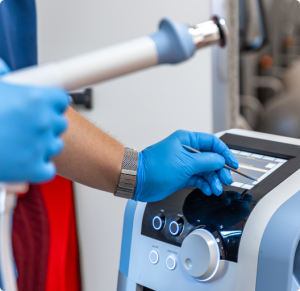Table of contents
Preclinical Testing
Preclinical testing includes laboratory evaluations carried out before clinical studies. These cover biocompatibility, mechanical strength, chemical properties, and microbiological assessments.
- Cytotoxicity of orthopedic implant materials
- Mechanical strength of knee and hip prostheses
- Toxicity of catheter materials for allergic reactions
Clinical Testing
Clinical trials assess medical devices in humans to confirm safety and efficacy. MDR requires studies to follow ISO 14155 and include proper study planning, ethics approval, patient recruitment, data analysis, and final reporting.
- Effectiveness of vascular stents in reducing restenosis
- Accuracy of continuous glucose monitors
- Comparison of new vs. traditional knee implants
EMC Testing
Electromagnetic compatibility (EMC) tests check whether devices perform correctly in environments with electromagnetic interference. This is crucial for hospital-based electronic equipment.
- Defibrillator reliability near other EM-emitting equipment
- Heart monitor stability near MRI machines
- EMC checks on mobile X-ray devices
Electrical Safety Testing (IEC 60601)
IEC 60601 is a globally accepted standard that defines requirements for the electrical safety and performance of medical devices. It is mandatory for CE certification under MDR.
- Protection from electric shock for users and patients
- Immunity to surges and EMI
- Mechanical durability and safety of device housing
- Functionality in varying humidity, temperature, and pressure
Usability Testing
Usability testing evaluates how end users (e.g., doctors, nurses) interact with the product under real-world conditions. It identifies use-related risks.
- Emergency use of auto-filling syringes
- Infusion pump UI evaluation
- Touchless thermometer usability in low-light settings
Post-Market Clinical Follow-Up (PMCF)
PMCF studies gather long-term data on device performance after market launch. They are essential for ongoing risk management and compliance with MDR.
- Long-term monitoring of implanted stents
- Performance tracking of new pacemakers
- Hearing aid effectiveness over multiple years

Analytical Testing for IVD Devices
Under IVDR 2017/746, IVD analytical testing ensures diagnostic accuracy and reliability. This includes performance, sensitivity, specificity, and stability evaluations.
- HPV test detection accuracy across all virus strains
- Glucose test reliability across various glucose levels
- SARS-CoV-2 antibody specificity versus other coronaviruses
The Role of GCB in Medical Device Testing
As a notified body, GCB plays a key role in the verification process of laboratory testing. Within the certification procedure, we review the technical documentation provided by the manufacturer, including test results performed by independent, accredited laboratories. We assess whether the test reports confirm compliance with the requirements of Regulations MDR 2017/745 and IVDR 2017/746.
Our task is to carry out a comprehensive technical and clinical evaluation, which forms the basis for issuing the CE certificate. This process includes a detailed verification of data, an audit of the quality management system, and a review of documentation consistency with applicable standards.
By choosing GCB for conformity assessment, you gain access to a team of experts with extensive experience in the evaluation of medical and diagnostic devices. We ensure a transparent and reliable certification process that supports manufacturers in successfully placing their products on the EU market.




























